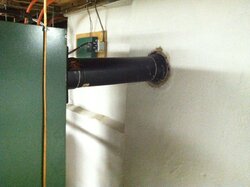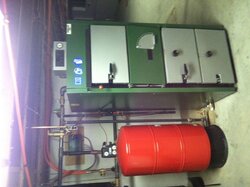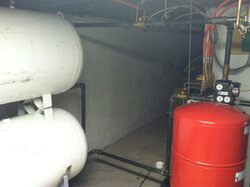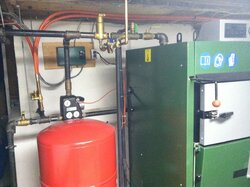Yeah, I forgot about the firebrick suggestion. I'll be doing something next year to stretch replacing the nozzle. Will post some pics and methods once I figure out how to remove the nozzle. I asked someone before and I think you have to remove the side blocks to get the nozzle out. I also see in the gaps something that looks like some type of woven, fiberglass rope. I'll figure it out when I get all the ceramics out. She's shut down for cleaning and storage plumbing. I wanna say, " Can't wait..", but yes I can. Glad Spring's here! Yep, gonna get some firebrick.
Fine Tuning BioMass
- Thread starter Tennman
- Start date
-
Active since 1995, Hearth.com is THE place on the internet for free information and advice about wood stoves, pellet stoves and other energy saving equipment.
We strive to provide opinions, articles, discussions and history related to Hearth Products and in a more general sense, energy issues.
We promote the EFFICIENT, RESPONSIBLE, CLEAN and SAFE use of all fuels, whether renewable or fossil.
You are using an out of date browser. It may not display this or other websites correctly.
You should upgrade or use an alternative browser.
You should upgrade or use an alternative browser.
Just fired my 60 for the first time yesterday. Using Mike's setting worked well. I'm using my pool w/he as a load so I can learn the finer points of running this before next winter rolls around.
I definately need practice maintaining optimal operation but I was able to take 12000gal from 67 to 80 in 9-10 hrs. I'm thrilled with that! Only ran through about 2 wheel barrel loads of wood to do that.
At this rate, I'll be ready for both winter and swimming soon
I definately need practice maintaining optimal operation but I was able to take 12000gal from 67 to 80 in 9-10 hrs. I'm thrilled with that! Only ran through about 2 wheel barrel loads of wood to do that.
At this rate, I'll be ready for both winter and swimming soon

Congrats and welcome Mark. I just noticed you posted here. Do you have storage? Well it's now mid-July so you should be doing some swimming now. Good to have more 60s running.
Yes, we are able to swim when we like despite the nonexistent summer. A few hours with the 60 and the pool is whatever temp we choose. I'm quite pleased with this boiler.
I do have 1500 gallons available for storage for this winter's heat I g and feel quite certain that my 60 will do great for us. Using my pool as a load has provided excellent experience in operating the Biomass.
I do have 1500 gallons available for storage for this winter's heat I g and feel quite certain that my 60 will do great for us. Using my pool as a load has provided excellent experience in operating the Biomass.
ElkRiverFJ
Member
Primaries wide open Air shutter wide open Secondaries almost closed, like 1/8 open Make sure the weight on the front flap is set so the damper is opening and closing when the fan is on/off. Load the boiler with your smallest splits first, then some kindling, then cardboard, then fill about 1/2 way with your regular wood. Light the cardboard and leave the door cracked until you are sure the fire is going to burn. Then close, shouldnt need to open again. You should have an almost instant secondary flame once the kindling gets going. Sometimes it will stall untill the first layer of splits gets going but should be gassing well within 20 minutes and stay that way until it is out of wood. I suspect your secondary is open too much and is blowing out the gassification flame. Also need to make sure the upper chamber is getting plenty of air, ecspecially if the wood is not well seasoned.
I just wanted to chime in to this thread to say thanks for all the information you give here. I have finished up a BioMass 25 install (well...almost done..I'm already seeing some modifications and rewiring I'd like to do...LOL).
I don't know what I would have done without this forum, and Mike's settings gave me a good starting point. Currently I am running with the following:
Fan Speed: 100%
Primaries : 90% open
Secondary: 25% open
Front shutter: approx 40%?? open
I will say my biggest problem is the old crutch that is repeated over and over: wood not dry enough. I suppose I was naive assuming my 1.5yr old white oak would be dry, but my newly acquired moisture meter is showing 20-32%.
My first few burns I was getting a lot of bridging and "blow through", but I have been able to tweak how I stack and I add in some lumber scraps (new home build) to the bottom which seems to help. I tried running with lower fan and lower openings on the Secondary, and it seems to be OK if I have dry wood, but the above settings seem to be best to make it all the way through a burn without a lot of fiddling. Again, I may be in a different ballgame with dry wood, I'll just have to wait and see. I know I've spent a lot of time down on my hands and knees peering through that sight glass at the flame..they should make an upside down periscope option for these things!
Oh, just to add, I have 800 gallons of pressurized storage (two vertical 400 gallon industrial air tanks), Utility room in basement of house houses the boiler, tanks and controls. The original plan was a shed but time and budget fell through on that.
jhunter19
Member
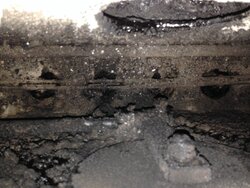 Well, toward the end of last winter, the cleanout handle broke off my Biomass 40 (this is my 5th break). so for about 2-3 weeks, I burned with out cleaning out the turbulators. Now I want to completely remove the turbulators and give the heat exchanges a good cleaning. Question 1: How do the turbulators come off the pin? I cannot seem to get it free. Question 2: what size brush should one use to clean the tubes? Please note my lift for removing the turbulators.
Well, toward the end of last winter, the cleanout handle broke off my Biomass 40 (this is my 5th break). so for about 2-3 weeks, I burned with out cleaning out the turbulators. Now I want to completely remove the turbulators and give the heat exchanges a good cleaning. Question 1: How do the turbulators come off the pin? I cannot seem to get it free. Question 2: what size brush should one use to clean the tubes? Please note my lift for removing the turbulators.woodsmaster
Minister of Fire
View attachment 116394 Well, toward the end of last winter, the cleanout handle broke off my Biomass 40 (this is my 5th break). so for about 2-3 weeks, I burned with out cleaning out the turbulators. Now I want to completely remove the turbulators and give the heat exchanges a good cleaning. Question 1: How do the turbulators come off the pin? I cannot seem to get it free. Question 2: what size brush should one use to clean the tubes? Please note my lift for removing the turbulators.
Wow, mine don't creosote like that. Four handles really ? You must be burning damp wood or doing a lot of idling. I dont even use the handle on mine. I unhooked it and clean the tubes two or three times a year when stack temps start climbing. I just have a steel rod threw the hole in each turb to hold them up and it makes them easy to take out for cleaning.
I've had the worst of both conditions; burning what I thot was dry wood and lots of idling. Not having storage I've spent a lot of time figuring out how to run our boiler at low efficiency to extend the burn as long as possible. Seen crud like yours mainly accumulate around the damper. #1 - I've learned to not be afraid of thrashing my handle hard. First year I was delicate on the turb handle. Now I let it drop pretty hard to get the shock value. But mainly I've developed the habit of using that cleaner 2-3 times a day and dropping the handle probably 4-6 or more times when I use it. I only takes seconds to do. I notice particularly since I'm not running wide open without storage, if I don't do it daily it has a noticeable growing resistance... the clue junk's accumulating on those turbs. Even with my conditions running far from ideal I've never come close to breaking the handle. How many times a day do you exercise the turbs. BTW, I didn't even know about cleaning that top chamber for about 3 years... Someone mentioned taking that top cover off and doing cleaning and I was stunned. A lot of stuff accumulated but mainly fluffy black sooty stuff. Not the hardened sticky stuff I'd see on my damper door. Looks like you have a wet wood problem. Also, running with my conditions I've had to clean off probably about as much as 3/16"-1/4" accumulation of crud under the damper (yep, I let it build up that long since I didn't know about that top cover!). I say all this to point out when I've seen stuff like this in my boiler it was just about always something bad I was doing.
GregMajecki
Member
This installation was done this fall. I have some questions that i would like to get answared.
Loading unit LK810 should i install plug or keep back flow preventer in. Also i am getting flow through house zone when loading unit is running and it’s getting worse with the water temp. gets higher. Zone pumps 07 IFC
I am having hard time bringing tanks to temperature. Loading unit pump on at 170F then the boiler temp. drops to 165F pump of and the process repeats.
Thanks Greg
Loading unit LK810 should i install plug or keep back flow preventer in. Also i am getting flow through house zone when loading unit is running and it’s getting worse with the water temp. gets higher. Zone pumps 07 IFC
I am having hard time bringing tanks to temperature. Loading unit pump on at 170F then the boiler temp. drops to 165F pump of and the process repeats.
Thanks Greg
Attachments
woodsmaster
Minister of Fire
how long have you been trying ? what are the tank temperatures ? Are you gassing good ? No smoke out the chimney ?
GregMajecki
Member
I always get smoke my flame is orange/purple so i think the boiler is gasifying ok. I always get black build up in the upper chamber. I have been trying to bring boiler up to temp 190 but the most i can get is 176. tank temp. I am not sure about i have placed the sensors on the tanks but they are not connected yet. I have to watch boiler over the weekend and see what the highest temp. i can get. One think i don't understand is the LK810 loading unit when the pump is not working lets water flow through it.
woodsmaster
Minister of Fire
If you can see smoke out the chimney you don't have your air adjusted right or have wet wood. there should,t be any smoke. black creosote in the upper chamber is normal. I don't Know any thing about that loading unit.
So, I've just completed my first week burning for heat since summer when I ran my 60 to heat my pool and learn its
's operation. While we are warm, I have to say I'm not so thrilled with the water-air exchange I'm running now but that wasn't unexpected. I hope to build new next year and will go radiant so thus should be only temporary.
That said, my delima lies in needing to run highrr temps for the exchangers. What's bothering me is the pump running all the time above 170 even when the 60 is idling or out of fuel. Seems to me I'm losing heat up the stack or to my boiler room when the unit isn't firing because the pump won't shut off closer to my target temp of 190-195.Am I just obcessing too much or is there a solution to keep the differential closer between pump on and target temp?
's operation. While we are warm, I have to say I'm not so thrilled with the water-air exchange I'm running now but that wasn't unexpected. I hope to build new next year and will go radiant so thus should be only temporary.
That said, my delima lies in needing to run highrr temps for the exchangers. What's bothering me is the pump running all the time above 170 even when the 60 is idling or out of fuel. Seems to me I'm losing heat up the stack or to my boiler room when the unit isn't firing because the pump won't shut off closer to my target temp of 190-195.Am I just obcessing too much or is there a solution to keep the differential closer between pump on and target temp?
GregMajecki
Member
You can get flue temperature sensor to control primary pump. I have one but not inslled yet
You get one from Dean http://www.smokelessheat.com
You get one from Dean http://www.smokelessheat.com
New owners especially, but us older owners also.... I highly recommend gently removing the side bricks in the upper chamber before you get them bonded in with creosote and hard ashes. I was told they simply pulled out but when they're hard glued in you have no way of knowing if what your doing is wrong, After 4 seasons my nozzle was so bad patching/fixing was not an option and you can't replace the nozzle without removing the side bricks. I not only had creosote down in the joints but it had bonded the backside of the side bricks to the metal. I wish I had known how they went in and out because they were locked in solid. We broke one side brick and damaged all of them. New Horizon has none of these in stock at the moment, so we'll wing it. We had to grind on the new nozzle sides to get it to go back in the steel cavity. Not a big deal, just letting you guys know my nozzle did not just drop in. With my Spring cleaning I will always now extract the side bricks to clean and not allow a 4 year buildup of goop to bond those in. Replacing the bottom chamber ceramics is easy, but in the upper chamber if you have no clue about what you're doing and they're stuck it is really ugly. It will never be easier to just see how they come out as before the first fire. Wish I had known. Merry Christmas to all!
BTW, I've plasma cut an expendable steel plate to lay over my nozzle. It covers the whole flap bottom of the upper chamber. It was cut from scrap mild steel and even if I go thru 2 of these a season it will be far simpler than redoing that nasty nozzle replacement. AND, last season the boiler efficiency went down the toilet with that nice big funnel for ashes to fall thru. Storage install going slow due to work commitments.
BTW, I've plasma cut an expendable steel plate to lay over my nozzle. It covers the whole flap bottom of the upper chamber. It was cut from scrap mild steel and even if I go thru 2 of these a season it will be far simpler than redoing that nasty nozzle replacement. AND, last season the boiler efficiency went down the toilet with that nice big funnel for ashes to fall thru. Storage install going slow due to work commitments.
Fred61
Minister of Fire
Ugly glue problems will subside when your storage is online. All the ceramics in my Eko upper chamber are white.
I'm really looking forward to that Fred, hard to imagine but I believe you. My work schedule is really hurting my storage install. But at least now I can fire her up and get off propane.
GregMajecki
Member
woodmaster
What are your air adjustments?
It seems like my air adjustment is all over the place. Sometimes I get good results with and another day I have to change it.
It seems like is impossible to get no smoke out of chimney.
I spoke with Zenon and he said no more then 1/4" on the secondary, but 1/4" is not working for my boiler. I have to open secondary to 50% of the hole then I get bright orange flan with some purple/blue.
What are your air adjustments?
It seems like my air adjustment is all over the place. Sometimes I get good results with and another day I have to change it.
It seems like is impossible to get no smoke out of chimney.
I spoke with Zenon and he said no more then 1/4" on the secondary, but 1/4" is not working for my boiler. I have to open secondary to 50% of the hole then I get bright orange flan with some purple/blue.
woodsmaster
Minister of Fire
Post 19 and 20 is still where I have my air set at. Iv'e burnt white ash and white oak with those settings and it works great. only time I get smoke is if I get some bridging. Havn't adjusted my air in a long time.
GregMajecki
Member
I am really frustrated with the biomass 40. I always get smoke and last few days a lot. This think smoke more than non-gasification stove.
Does anybody have procedure (stapes) to follow, thinks to check to tune the boiler.
Does anybody have procedure (stapes) to follow, thinks to check to tune the boiler.
Greg, I'm presuming this is your first season so let me reassure you... I'm 99.9% sure it's wood, tuning, or one or your processes. My first season my wood was far from idea and when I had a good coal bed there was very little smoke. I'll bet your settings aren't far off. Hopefully another 40 user will chime in. I'm always looking out the window at my flue for a hint of smoke telling me I have a blow thru hole. I used to try to burn much larger splits and have found smaller splits and higher setting temps dramatically reduces bridging and blow holes. You will learn over time how to stack and keep a good coal bed. I find even poorly seasoned wood will burn smoke free with a good coal bed. So try smaller splits, 3"-4" in dia. Until I got really dry wood I stacked to one side to avoid bridging which is basically the wood burning a big cavity over the nozzle and the wood not falling and keeping the nozzle covered with a heathy bed of coals. Smoke is my clue that for some reason a hole has been blown thru my coal bed. In the past I found it more frequent when I tried to burn splits too big for the quality of my wood to keep that coal bed over the nozzle. Your problem is not a Biomass problem, it is common to new gasification boiler users, so I suggest you post a thread in the General Discussions where you'll get lots of good advice. So be patient and understand there absolutely is a learning curve to operating a gasification boiler and you'll see many things that effect it's operation.
GregMajecki
Member
You are right Tennman good bed of coal is a key. I was burning all weekend and there was no smoke or very little when bridging.
But during week days when i load and leave for all day it smokes. How do you establish good bed of coals?
But during week days when i load and leave for all day it smokes. How do you establish good bed of coals?
Fred61
Minister of Fire
I find even poorly seasoned wood will burn smoke free with a good coal bed.
I don't have a Biomass but with my 50 years experience burning wood, fifteen years with a gasser, I thought I might offer this nerdle of information. What you want to accomplish with your statement above is going to be difficult because poorly seasoned wood doesn't coal up well. The coals that get produced burn away faster than new make-up coals are being produced. That's what we call bridging. The fan fed fire is only burning on the extreme outer surface of the log while it's evaporating the water in the wood below the burning surface, resulting in low production of coals. Put a real dry split it in your firebox at peak burn and you'll see it turn into a pile of coals in no time.
It never occurred to me that my poorly seasoned wood's burn rate contributed to those hollow bridging cavities. I sensed the wet wood contributed but at the same time I discovered much smaller splits reduced the likelihood. Early on I put poorly seasoned 6-8" splits in and they would just burn and form like a keystone which physically prevented the wood from falling on the coals. Now that I have really well seasoned wood I still split 3-4" which really reduces how often I need to pamper the burn. I'm sure Fred's point is correct and with larger splits the chance of creating that keystone effect is greater. That's why for one season I didn't stack the wood level but leaned it to one side... Hated that it hurt my burn time since I couldn't fill the boiler but by doing that gravity was my friend and the wood burned and fell like an avalanche. Make sense? All band aids for poor wood. Took me the better part of 3 years to get to where I had no kidding real seasoned wood and finally many of the problems of my first 2 seasons started to fall away. First year and much of second I was bringing what i thot was seasoned wood out of the hills as fast as I was burning it so the boiler never got its proper food until the difference. I don't disagree with Fred and the keystone bridging problem is more likely with big splits. I burn mostly oak and hickory now with at least 2 years of seasoning. Lots to learn but you'll get there and the sooner you get dry wood the sooner you'll see how these thing want to run. Kinda like running your gas car on diesel and getting frustrated at it puking... I know.. Been there.
I'm getting bridging with the wood variety. Though all of my stock isn't quite as dry as it should be, most burns well. However, I've got a few Tulips in there and those don't burn well in my 60 at all. I know from previous updraft experience that such trees don't produce the heat that other varieties will but I burned them, no the less. I can't put more that a couple pieces in at once or it bridges quite quickly.
Most of my stock is maple and oak and those do fine so I'm blending in a bit of the Tulip at a time to get rid of it.
I surely won't be cutting any more of those in the future. I guess I'll just drop 'em for the mushrooms to eat.
Most of my stock is maple and oak and those do fine so I'm blending in a bit of the Tulip at a time to get rid of it.
I surely won't be cutting any more of those in the future. I guess I'll just drop 'em for the mushrooms to eat.
Similar threads
- Replies
- 3
- Views
- 572
- Replies
- 23
- Views
- 2K
- Replies
- 4
- Views
- 3K


